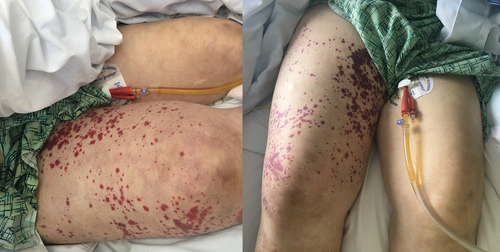Unilateral purpura resulting from deep vein thrombosis
A 72-year-old man presented with complaint of acute swelling and pain in his right leg. He had been in his usual state of health until 2 days prior, when he developed pain in the right upper thigh, which then spread down the right lower extremity and was associated with a new rash. His past medical history was notable for cirrhosis (Childs-Pugh class C) secondary to alcohol abuse, complicated by esophageal varices and chronic thrombocytopenia. On exam, he was noted to have a unilateral, painless, purpuric rash on the right thigh (1), and the right lower extremity was significantly larger than the left. Laboratory values were notable for a white blood cell count of 10.2 × 103 cells/μL, hemoglobin 9.8 g/dL, platelets 57 × 103/μL, INR 1.8, fibrinogen 189 mg/dL, creatinine 1.0 mg/dL, AST 32 u/L, ALT 25 u/L, and total bilirubin of 2.3 mg/dL. Ultrasonography revealed an extensive, proximal deep vein thrombosis (DVT) involving the right femoral vein.

Purpura results from blood extravasating from small vessels. This can be due to coagulopathy, immunologic injury to vessels,1 or increased venous pressure due to stasis.2 These processes are typically generalized and thus, if the lower extremities are involved, a degree of symmetry is expected. Rare cases of unilateral linear capillaritis have been described but the mechanism of such cases is unclear.3 Other rare causes of asymmetric purpura have been attributed to unilateral Schamberg disease4 or lichen purpuricus.5, 6 While DVT is associated with an acute increase in venous pressure, for unclear reasons it rarely causes purpura, having been described just once previously in the literature.7, 8 In our patient, we hypothesize that the purpura in this case was due to a combination of acutely increased venous pressure from the large proximal DVT on a background of coagulopathy and thrombocytopenia from advanced liver disease. Unilateral purpura is a rare presenting sign of DVT.
CONFLICT OF INTEREST
None of the authors report any conflicts of interest.
AUTHOR CONTRIBUTIONS
All co-authors have seen and agree with the contents of the manuscript and have contributed significantly to the work.
INFORMED CONSENT
The patient provided written informed consent.




